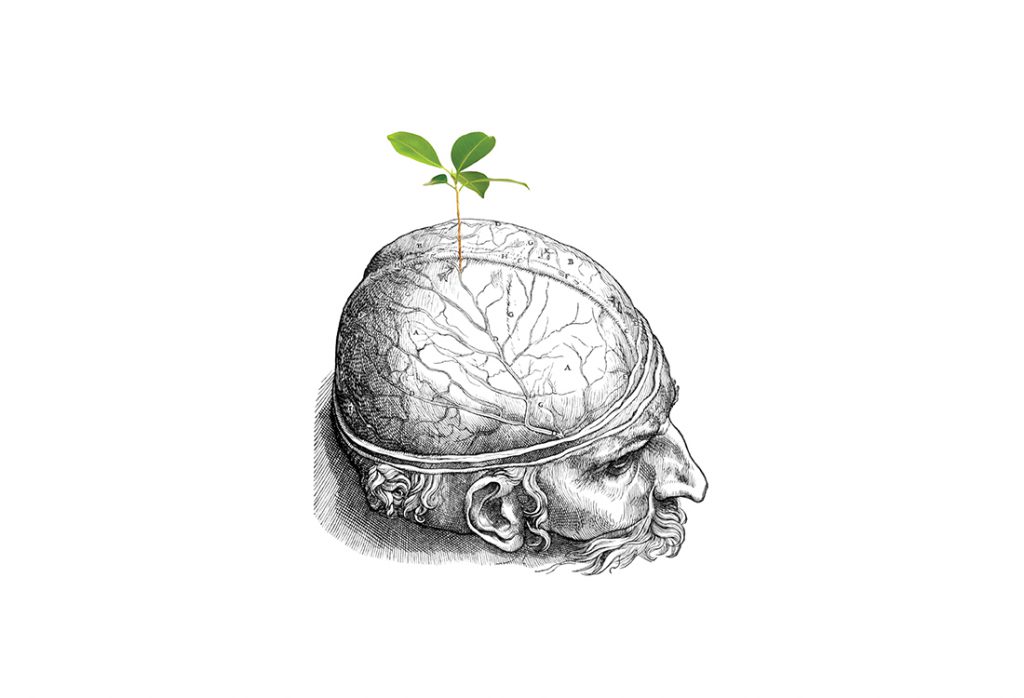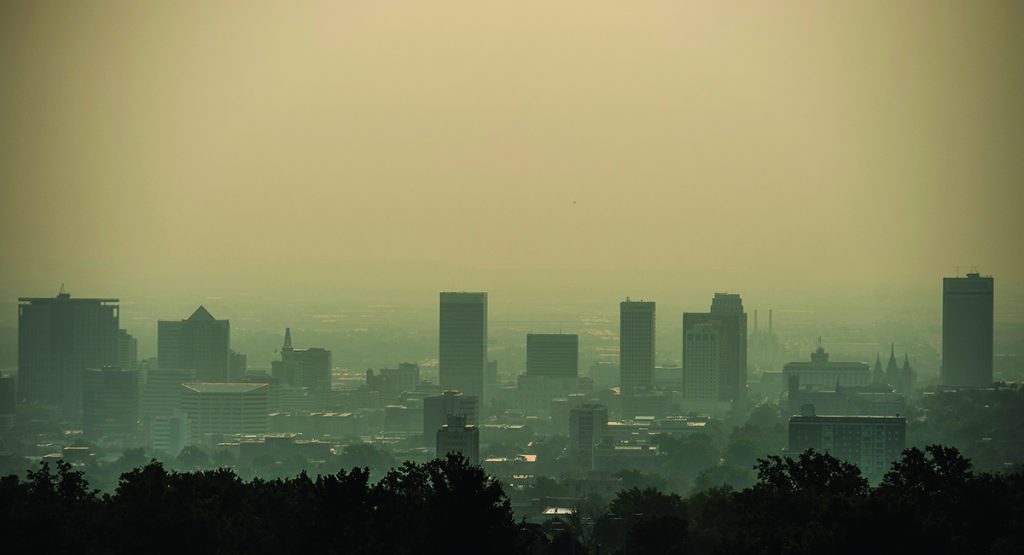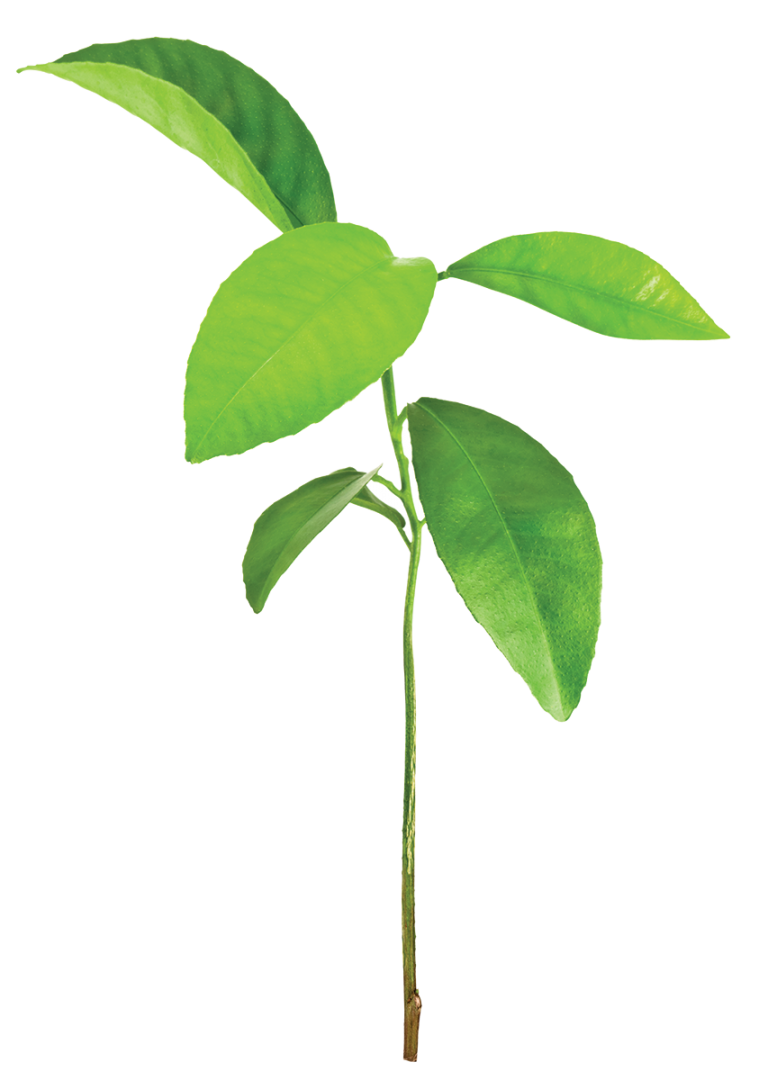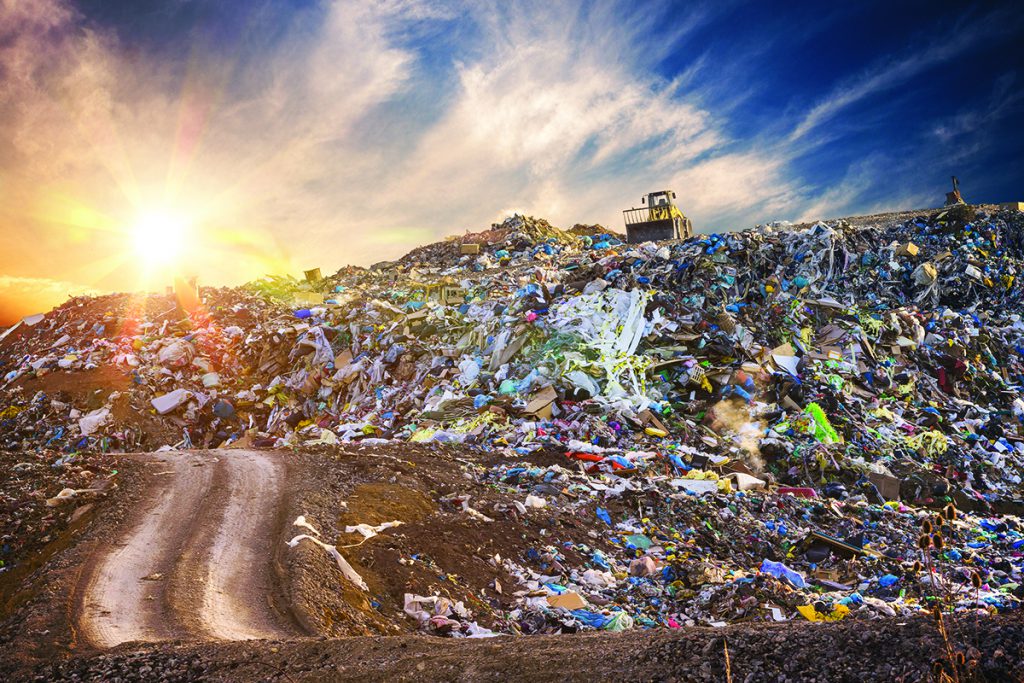
Finding Hope

Westminster community members offer insight into stepping outside of fear with regard to climate change
by Autumn Thatcher (MSC ’15)
Salt Lake’s winter inversion is in full effect. The polluted air outside my window is grey and makes my throat burn when I walk outside. My skin is drying and cracking; my eyes sting. On a global level, the ice is melting, the oceans are becoming more and more polluted with our trash, rainforests and mountains are burning, and millions of animals are dying. People are losing their homes—their lives. The water is drying up, and my fear is rising. Climate change is happening right in front of us. Taking a step outside of my fear and just thinking about what is happening makes everything feel so apocalyptic. This could be an apocalypse, but there are no zombies, and I am not wearing that awesome zombie-fighting outfit I imagined being decked out in. This is real life, and I have no idea how to survive it.
Westminster alum Michael Shea (’08) refers to the feelings of fear and sadness regarding climate change as climate grief. He tells me that it is easy to get stuck in the grief cycle, but I cannot allow myself to stay there. How do I step outside of that fear into hope? Is there even a reason to be hopeful at this point? I figured that if I am feeling this way, then there is a good chance that other people are too.
I begin my quest to answer these questions by reading an article written by Jonathan Franzen for the New Yorker entitled “What if We Stop Pretending?” In his article, Franzen addresses climate change and whether or not hope is possible. The piece is both devastatingly somber and strangely reassuring—not because it offers any form of optimism, but rather because, in being so direct, Franzen gives us permission to remember that we are human. The future, with regard to climate, is grim. But, as Franzen suggests, if we rethink how we define hope, then we may be able to survive it.
I finish this article feeling a little less depressed but still just as overwhelmed and uncertain. From here, I determine that it’s time to take my tough questions to Westminster community members. I speak with two professors, an alumnus, and a current student—all of whom are involved with moving the climate conversation forward in different ways. Over the course of my interviews, I learn what it means to have hope and how hope should influence action. I learn that we can, each one of us, make a difference.
"There is no absolute crisis or absolute hope. Crisis and hope are intertwined in a dynamic relationship like two tango dancers."
-Professor Xiumei Pu
Beginning with empathy
In the fall of 2019, hope was an integral piece of two of Professor Xiumei Pu’s courses: Introduction to Environmental Studies, a class she team-taught with Professor Brent Olson, and Spiritual Ecology. “In 2016, I observed a range of emotions when my students learned about a host of environmental issues such as climate change: guilt, sadness, despair, you name it,” Xiumei says. “Spiritual Ecology was created to hunt for hope in a world as challenging as this one we are currently living in.”
In thinking about Franzen’s article, I ask Xiumei how she defines climate hope. “To me, climate hope depends on both feasible short-term solutions and visionary long-term solutions,” she says. Xiumei explains that many philosophers trace the root cause of climate change and environmental destruction to the types of worldviews that power particular types of economies and lifeways. “That’s to say, climate hope relies on a shift away from carbon-intensive economies and lifeways and a paradigm shift in anthropocentric worldviews.”
An anthropocentric worldview is one that considers human beings as the most important entity of the universe, regarding the world in terms of human values and experiences. But each experience is different and, as we know, we are not the only life form inhabiting this earth. We are, however, the most evolved, which is perhaps why humans have so significantly contributed to climate change. Enter the guilt and shame. But those feelings are not productive. Xiumei sees crisis and hope as two sides of reality—similar, she says, to the Daoist concept of yin and yang. “There is no absolute crisis or absolute hope. Crisis and hope are intertwined in a dynamic relationship like two tango dancers,” Xiumei explains. “Sometimes, crisis looms large; other times, hope comes into view. The relationship between crisis and hope is always in flux. Recognizing that keeps me going.”
Xiumei encourages action; it’s not too late to make a difference. We just have to start somewhere—and be realistic with ourselves. “It’s important to do something that’s doable for your situation,” Xiumei says. “Action will look different for different people.”
And, Xiumei says, be compassionate to yourself. “One can easily burn out dealing with environmental problems like climate change. I cannot emphasize enough the importance of self-care. Recognize that it will be a long, collective walk. Find like-minded travel companions, and be persistent.”

(Chris Detrick | The Salt Lake Tribune) Smoke from wildfires burning across the western U.S. is worsening air conditions on the Wasatch Front, as seen in downtown Salt Lake City Wednesday, September 6, 2017.
Becoming an educated consumer
Professor John Watkins teaches economics at Westminster. In the fall of 2019, he was part of a learning community focused on climate change. Professor Michael Popich also participated in this learning community, which served as a general introduction to economics and looked at ethical issues of injustice that economic practices can raise. “When you address this issue of climate change and try to alter the trajectory, it involves both economic and ethical issues. The class addressed both the ethical and moral issues and dealt with this issue of economic growth and how to sustain that growth,” John says.
It’s safe to say that most of us are well aware of the need businesses have for us to buy more. Consumerism is alive and well, even in the face of overflowing landfills and waste drowning in our oceans. “If you look in people’s basements, attics, or garages, they’re stuffed with stuff. They might use it for a little bit, but then it gets dumped in a landfill,” John says. This is, of course, concerning; but John notes that what is required is a change in institutions: social structures that channel individual choices and activities to mitigate the effects of climate change. “It’s really the fossil fuels that are the crux of the problem,” John says. “Somehow, we need to shift the focus of the capitalist system.”
John knows that shifting that focus is no easy feat, but one step toward generating change is becoming more consciously minded. Additionally, he encourages individuals to use their voting power to ensure that we are electing government officials who will shift that focus. I skeptically ask John if it is possible to be a good consumer and help with the economy without damaging the earth. He informs me that it is and that education is key. John points to the textile industry as an area in which consumers can be more consciously minded—and cites it as an example of how he, too, is continually learning.
"I’m a single person, but when you multiply that by 100 million people or a billion people, then it becomes significant.”
- Professor John Watkins
“I recently watched a documentary on Netflix called True Cost, from which I learned that the textile industry is the second most pollution-intensive industry in the world. But there are a number of entrepreneurs in the fashion industry who are working to make people aware of how much waste there is in the industry,” John says.
I watched the trailer for True Cost, and I am shocked. John reminds me that becoming conscious of climate change is a good place to start in making a difference. And, he says, despite how miniscule we may feel, one person can make a difference. “Climate change with regard to economics is like a ‘public bad.’ If I am harmed by climate change, a ‘public bad’ means that you can also be harmed,” John explains. “The flip side of that is my effort to make a difference. I’m a single person, but when you multiply that by 100 million people or a billion people, then it becomes significant.”

Thinking Locally
Go behind the scenes with Michael and Autumn as they discuss how to think locally during climate change and what our community can do to push for legislative change:
WestminsterSLC · Finding Hope: Michael Shay ('08)After spending years working as the policy director for Heal Utah, a nonprofit environmental watchdog group, Michael Shea (’08) was recruited to work as the environmental programs manager for Salt Lake County. Internally, his work involves examining the infrastructure for how it operates and maintains services such as garbage trucks, road maintenance, and landfills and identifying ways in which the county can make the biggest improvements—especially as it relates to air quality. Externally, Michael is trying to develop policy proposals for the mayor to take to the legislative level, such as passing legislation to ensure that Salt Lake County is using 100 percent renewable energy by 2030.
Michael grew up in Utah and has been an avid outdoorsman his entire life. He was inspired to turn toward environmental activism after taking classes by Westminster professors such as John Watkins, Michael Popich, and Dick Chapman. Having spent years advocating on behalf of Utah’s environment, Michael is intimately aware of “this giant global catastrophe that’s unfolding before our eyes.” I ask Michael how he stays motivated. “The trick is that you have to think locally,” he says. “You have to think, ‘What can I do as an individual? What can I do to influence my community, city, state, and country?’ And realize that you are just one small part of thousands, if not millions, of those same conversations.”
On a global level, scientific reports, such as one released by the United Nation’s Intergovernmental Panel on Climate Change in 2018, indicate that a worsening of food shortages and wildfires, in addition to a mass die-off of coral reefs, could happen as soon as 2040. This report says that avoiding the damage requires transforming the world economy in a way that has “no documented historic precedent.” Indicators such as these have influenced many around the world to talk about how to prevent greenhouse gas emissions from continuing at their current rate in order to avoid the earth warming by as much as 2.7°F. We know we need to change, but can it actually happen in time? Perhaps not, but, Michael says, we can work to stave off the worst of it. And that is exactly what he is dedicated to doing in his current role with the county.
“I have good days and bad days, but I do think we’ll be able to make it. I think there will be enough systemic change—enough individuals pushing for change—that we will be able to move the needle to avoid the worst of it. But as a society, we will still have to adjust to the new reality of what a post–climate-change world will look like. It will be a hard adjustment.”
"The trick is that you have to think locally. You have to think, ‘What can I do as an individual?’”
- Michael Shea (’08)
In Utah, residents might face drought; an increase in wildfires—possibly along the Wasatch front; less snow pack, which affects our water supply and ties into local agriculture and business; worsened air pollution; a shortened ski season, which affects the local economy; and the list goes on. It’s terrifying, but Michael encourages Utah locals to try not to become overwhelmed by the climate conversation. Instead, he says, focus on what you can do as an individual, such as carpooling (he reveals that emissions from vehicles are the number-one contributor to air pollution in Utah), remembering not to idle in vehicles, recycling, and just being more consciously minded in day-to-day decisions. He also reminds us to think beyond our individual actions. “Individual choices are very important, but it’s also important to think about how you can influence the larger community as a whole. And to that end, I would say, get involved in politics.”
Communicating with local politicians, both Republican and Democrat, can be very effective. “People have the ability to make the large systematic change that needs to happen, and those are the people in office, the politicians. And as much as I think we disparage politics, there really are big differences to be made if you can get the right people into office.”
When talking about climate change with skeptics or deniers, Michael suggests being open to differences of opinion and removing buzz words like climate and environment from the conversations. Instead, he encourages talking about the importance of reducing emissions or growing a sustainable economy. “It’s much more effective to get others on board by having a conversation rather than giving a lecture.”

Building Community
Go behind the scenes with Eliza and Autumn as they discuss the disparity of those most affected by climate change and how to build community through this fight:
Eliza Van Dyk (’21) is somewhat of a local celebrity. In her time at Westminster, she has actively led climate-justice–related protests at the Capitol aimed at government officials responsible for making decisions that affect the state of Utah and the people living in it.
She has written op-eds in publications like the Salt Lake Tribune and has led many student-run initiatives on campus, in between volunteering for nonprofits that bring together youth advocating for climate justice. Eliza believes that our power lies in our collective ability to challenge institutions and make systemic change—and proudly identifies as one of the many young people who have made headlines with their efforts to bring awareness to the catastrophic conditions this planet may soon face. Eliza, like so many of those in this movement under the age of 32, wants older generations to pay attention—but not just to the fact that greenhouse emissions and mass production are warming the planet: she wants others to acknowledge those who are affected most by this crisis.
“Climate change impacts people disproportionately. An example of this in our specific region is that there’s a lot of resource extraction that happens on the lands of sovereign indigenous nations. Most often we’ll see that the communities who are living with the most pollution are communities of color and low-income communities. We’re really trying to re-center climate change as a social-justice issue and recognize that the actions we take in response to this climate crisis have to be considerate of socioeconomic inequalities,”
"We have to be building resilient communities right now because, no matter what, our climate is changing."
- Eliza Van Dyk (’21)
Eliza is unsure of whether we can reduce our emissions enough in the next 10 years to reverse the climate crisis. But she is sure that change is inevitable, and despite how terrible it could be, she has hope. “A lot of the hope that I find really comes from the young people. There are young people who are doing amazing things in response to a potentially really scary future. In my personal life, it’s been amazing to build relationships and be united by the climate crisis to imagine a just and livable future for everyone,” she explains. “We have to be building resilient communities right now because, no matter what, our climate is changing. It really opens up this opportunity for us to be in solidarity with each other in our communities and to redistribute resources so that we can build communities of care.”
Throughout each interview that I have conducted for this story, I am reminded of the importance of action and how that looks different for everyone. There are so many areas to get involved in or contribute to; and, as Eliza suggests, there is no better place to start than in our communities—our homes. I take this to mean home both in the sense of individual places of residence as well as the homes we build around us through community action. As individuals, we can make small differences in our daily routine like bringing reusable dinnerware to work to eat our lunches on. Or keeping bags in our cars for when we go shopping. Or skipping watering lawns in an effort to not contribute to water waste. But we can also make a difference by meeting one another and having conversations. We can get to know our neighbors on different sides of the valley or state: bloom where we are planted.
My experience in writing this piece has been an emotional one, filled with ups and downs. But each interview has left me inspired and, dare I say, hopeful. “Feeling hopeful is important because it’s the belief that we are resilient and that, at the core of our humanity, we believe in justice, and we believe in young people,” Eliza says. “It’s okay to have days where it’s hard to think about how things will get any better. But there are people constantly working on these issues—and hope is our greatest strength in this time.”
Additional Resources
In the Dark by Rebecca Solnit
The New Yorker, “What if We Stopped Pretending?” by Jonathan Franzen
Utah Department of Environmental Quality
About the Westminster Review
The Westminster Review is Westminster University’s bi-annual alumni magazine that is distributed to alumni and community members. Each issue aims to keep alumni updated on campus current events and highlights the accomplishments of current students, professors, and Westminster alum.
GET THE REVIEW IN PRINT STAY IN TOUCH SUBMIT YOUR STORY IDEA READ MORE WESTMINSTER STORIES